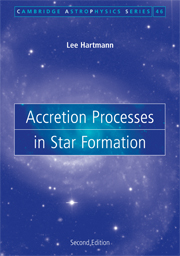Book contents
- Frontmatter
- Contents
- Preface to the first edition
- Preface to the second edition
- Acknowledgments
- 1 Overview
- 2 Beginnings: molecular clouds
- 3 Initial conditions for protostellar collapse
- 4 Protostellar cloud collapse
- 5 Protostellar collapse: observations vs. theory
- 6 Binaries, clusters, and the IMF
- 7 Disk accretion
- 8 The disks of pre-main-sequence stars
- 9 The FU Orionis objects
- 10 Disk winds, jets, and magnetospheric accretion
- 11 Disk accretion and early stellar evolution
- 12 Disk evolution and planet formation
- Appendix 1 Basic hydrodynamic and MHD equations
- Appendix 2 Jeans masses and fragmentation
- Appendix 3 Basic radiative transfer
- List of symbols
- Bibliography
- Index
2 - Beginnings: molecular clouds
Published online by Cambridge University Press: 30 October 2009
- Frontmatter
- Contents
- Preface to the first edition
- Preface to the second edition
- Acknowledgments
- 1 Overview
- 2 Beginnings: molecular clouds
- 3 Initial conditions for protostellar collapse
- 4 Protostellar cloud collapse
- 5 Protostellar collapse: observations vs. theory
- 6 Binaries, clusters, and the IMF
- 7 Disk accretion
- 8 The disks of pre-main-sequence stars
- 9 The FU Orionis objects
- 10 Disk winds, jets, and magnetospheric accretion
- 11 Disk accretion and early stellar evolution
- 12 Disk evolution and planet formation
- Appendix 1 Basic hydrodynamic and MHD equations
- Appendix 2 Jeans masses and fragmentation
- Appendix 3 Basic radiative transfer
- List of symbols
- Bibliography
- Index
Summary
Star formation in our galaxy at present occurs in dense, cold clouds of molecular gas. The efficiency of star formation is generally low. While there are localized regions of high efficiency which produce bound star clusters, typical star formation efficiencies of nearby molecular cloud complexes are a few percent by mass. For a long time it was thought that this low efficiency of converting gas to stars was due to the slowing of gravitational collapse by magnetic fields. However, most nearby molecular clouds of significant mass harbor young stars, with typical ages of a few Myr, indicating that star formation is relatively rapid and that (at least local) molecular clouds are not long-lived, casting doubt on the importance of magnetic fields. The low efficiency of star formation is not due to the slowing gravitational collapse but to the disruption of molecular gas by stellar energy input, particularly from massive stars, which disperse clouds before all the mass can collapse.
The processes by which large molecular clouds fragment into molecular cloud cores, the precursors of protostars, are not yet well understood. Lower-density gas must be concentrated into dense regions, often filamentary in structure, with low(er) “turbulent” motions. Numerical simulations show that supersonic turbulence can create protostellar cores with the aid of rapid cooling and even thermal instability, which then gravitationally collapse.
- Type
- Chapter
- Information
- Accretion Processes in Star Formation , pp. 21 - 42Publisher: Cambridge University PressPrint publication year: 2008



